Density Functional Theory Provides Insights into β-SnSe Monolayers as a Highly Sensitive and Recoverable Ozone Sensing Material
Abstract
1. Introduction
2. Materials and Methods
3. Results and Discussion
3.1. Structures
3.2. Electronic Properties
3.3. Recovery Time
3.4. Sensitivity
3.5. Comparison
4. Conclusions
Supplementary Materials
Author Contributions
Funding
Data Availability Statement
Acknowledgments
Conflicts of Interest
References
- Kamalinahad, S.; Solimannejad, M.; Shakerzadeh, E. Sensing of Ozone (O3) Molecule via Pristine Singe-Walled Aluminum Nitride Nanotube: A DFT Study. Superlattices Microstruct. 2016, 89, 390–397. [Google Scholar] [CrossRef]
- Munsif, S.; Ayub, K.; Nur-e-Alam, M.; Ahmed, S.; Ahmad, A.; Ul-Haq, Z. Sensing of H2S, NO2, SO2, and O3 through Pristine and Ni-Doped Zn12O12 Nanocage. Comput. Theor. Chem. 2023, 1229, 114305. [Google Scholar] [CrossRef]
- Rad, A.S.; Ayub, K. O3 and SO2 Sensing Concept on Extended Surface of B12N12 Nanocages Modified by Nickel Decoration: A Comprehensive DFT Study. Solid State Sci. 2017, 69, 22–30. [Google Scholar] [CrossRef]
- Panahyab, A.; Soleymanabadi, H. Ozone Adsorption on a BN Fullerene-like Nano-Cage: A DFT Study. Main Group Chem. 2016, 15, 347–354. [Google Scholar] [CrossRef]
- Roy, D.; Hossain, M.R.; Hossain, M.K.; Hossain, M.A.; Ahmed, F. Density Functional Theory Study of the Sensing of Ozone Gas Molecules by Using Fullerene-like Group-III Nitride Nanostructures. Phys. B Condens. Matter 2023, 650, 414553. [Google Scholar] [CrossRef]
- Abd-Elkader, O.H.; Sakr, M.A.S.; Saad, M.A.; Abdelsalam, H.; Zhang, Q. Electronic and Gas Sensing Properties of Ultrathin TiO2 Quantum Dots: A First-Principles Study. Results Phys. 2023, 52, 106804. [Google Scholar] [CrossRef]
- Abbasi, A.; Sardroodi, J.J. Application of TiO2-Supported Au for Ozone Molecule Removal from Environment: A van Der Waals-Corrected DFT Study. Int. J. Environ. Sci. Technol. 2019, 16, 3483–3496. [Google Scholar] [CrossRef]
- Abbasi, A.; Sardroodi, J.J. Investigation of the Adsorption of Ozone Molecules on TiO2/WSe2 Nanocomposites by DFT Computations: Applications to Gas Sensor Devices. Appl. Surf. Sci. 2018, 436, 27–41. [Google Scholar] [CrossRef]
- Rad, A.S.; Shabestari, S.S.; Mohseni, S.; Aghouzi, S.A. Study on the Adsorption Properties of O3, SO2, and SO3 on B-Doped Graphene Using DFT Calculations. J. Solid State Chem. 2016, 237, 204–210. [Google Scholar] [CrossRef]
- Shokuhi Rad, A.; Zareyee, D. Adsorption Properties of SO2 and O3 Molecules on Pt-Decorated Graphene: A Theoretical Study. Vacuum 2016, 130, 113–118. [Google Scholar] [CrossRef]
- Singh, S.; Goswamy, J.K.; Sapra, G.; Sharma, P. Sensitivity and Selectivity Analysis of Toxic Gases NO2, SO2, O3, Cl2, (CH3)2NH, CH3NH2, NH3, HCl, CH2CHCl and ClO2 on GO Sheet Platform for Environmental Sustainability: A DFT Prediction. Sens. Actuators A Phys. 2022, 347, 113899. [Google Scholar] [CrossRef]
- Abbasi, A.; Sardroodi, J.J. The Adsorption of Sulfur Trioxide and Ozone Molecules on Stanene Nanosheets Investigated by DFT: Applications to Gas Sensor Devices. Phys. E Low-Dimens. Syst. Nanostruct. 2019, 108, 382–390. [Google Scholar] [CrossRef]
- Abbasi, A.; Sardroodi, J.J. Exploration of Sensing of Nitrogen Dioxide and Ozone Molecules Using Novel TiO2/Stanene Heterostructures Employing DFT Calculations. Appl. Surf. Sci. 2018, 442, 368–381. [Google Scholar] [CrossRef]
- Shukla, A.; Gaur, N.K. Adsorption of O3, SO3 and CH2O on Two Dimensional SnS Monolayer: A First Principles Study. Phys. B Condens. Matter 2019, 572, 12–17. [Google Scholar] [CrossRef]
- Chatterji, T.; Wdowik, U.D.; Jagło, G.; Rols, S.; Wagner, F.R. Soft-Phonon Dynamics of the Thermoelectric β-SnSe at High Temperatures. Phys. Lett. A 2018, 382, 1937–1941. [Google Scholar] [CrossRef]
- Hu, Z.-Y.; Li, K.-Y.; Lu, Y.; Huang, Y.; Shao, X.-H. High Thermoelectric Performances of Monolayer SnSe Allotropes. Nanoscale 2017, 9, 16093–16100. [Google Scholar] [CrossRef] [PubMed]
- Ma, L.; Li, J.; Wang, Y. Optimizing the Electrical Transport Properties of InBr via Pressure Regulation. J. Appl. Phys. 2018, 124, 185103. [Google Scholar] [CrossRef]
- Luo, M.; Yin, H. Effects of Electric Field on Electronic and Optical Properties of SnSe: A First-Principle Study. Integr. Ferroelectr. 2020, 211, 167–174. [Google Scholar] [CrossRef]
- Liu, T.; Qin, H.; Yang, D.; Zhang, G. First Principles Study of Gas Molecules Adsorption on Monolayered β-SnSe. Coatings 2019, 9, 390. [Google Scholar] [CrossRef]
- Kresse, G.G.; Furthmüller, J.J. Efficient Iterative Schemes for Ab Initio Total-Energy Calculations Using a Plane-Wave Basis Set. Phys. Rev. B Condens. Matter 1996, 54, 11169. [Google Scholar] [CrossRef]
- Kresse, G.; Furthmüller, J. Efficiency of Ab-Initio Total Energy Calculations for Metals and Semiconductors Using a Plane-Wave Basis Set. Comput. Mater. Sci. 1996, 6, 15–50. [Google Scholar] [CrossRef]
- Perdew, J.P.; Burke, K.; Ernzerhof, M. Erratum Generalized Gradient Approximation Made Simple. Phys. Rev. Lett. 1996, 78, 1396. [Google Scholar] [CrossRef]
- Grimme, S. Semiempirical GGA-Type Density Functional Constructed with a Long-Range Dispersion Correction. J. Comput. Chem. 2010, 27, 1787–1799. [Google Scholar] [CrossRef] [PubMed]
- Soler, J.M.; Artacho, E.; Gale, J.D.; García, A.; Junquera, J.; Ordejón, P.; Sánchez-Portal, D. The SIESTA Method for Ab Initio Order-N Materials Simulation. J. Phys. Condens. Matter 2002, 14, 2745. [Google Scholar] [CrossRef]
- Meir, Y.; Wingreen, N.S. Landauer Formula for the Current through an Interacting Electron Region. Phys. Rev. Lett. 1992, 68, 2512–2515. [Google Scholar] [CrossRef] [PubMed]
- Momma, K.; Izumi, F. VESTA3 for Three-Dimensional Visualization of Crystal, Volumetric and Morphology Data. J. Appl. Crystallogr. 2011, 44, 1272–1276. [Google Scholar] [CrossRef]
- Wang, V.; Xu, N.; Liu, J.-C.; Tang, G.; Geng, W.-T. VASPKIT: A User-Friendly Interface Facilitating High-Throughput Computing and Analysis Using VASP Code. Comput. Phys. Commun. 2021, 267, 108033. [Google Scholar] [CrossRef]
- Jiang, X.; Zhang, G.; Yi, W.; Yang, T.; Liu, X. Penta-BeP2 Monolayer: A Superior Sensor for Detecting Toxic Gases in the Air with Excellent Sensitivity, Selectivity, and Reversibility. ACS Appl. Mater. Interfaces 2022, 14, 35229–35236. [Google Scholar] [CrossRef]
- Abbasi, A.; Sardroodi, J.J. Adsorption of O3, SO2 and SO3 Gas Molecules on MoS2 Monolayers: A Computational Investigation. Appl. Surf. Sci. 2019, 469, 781–791. [Google Scholar] [CrossRef]
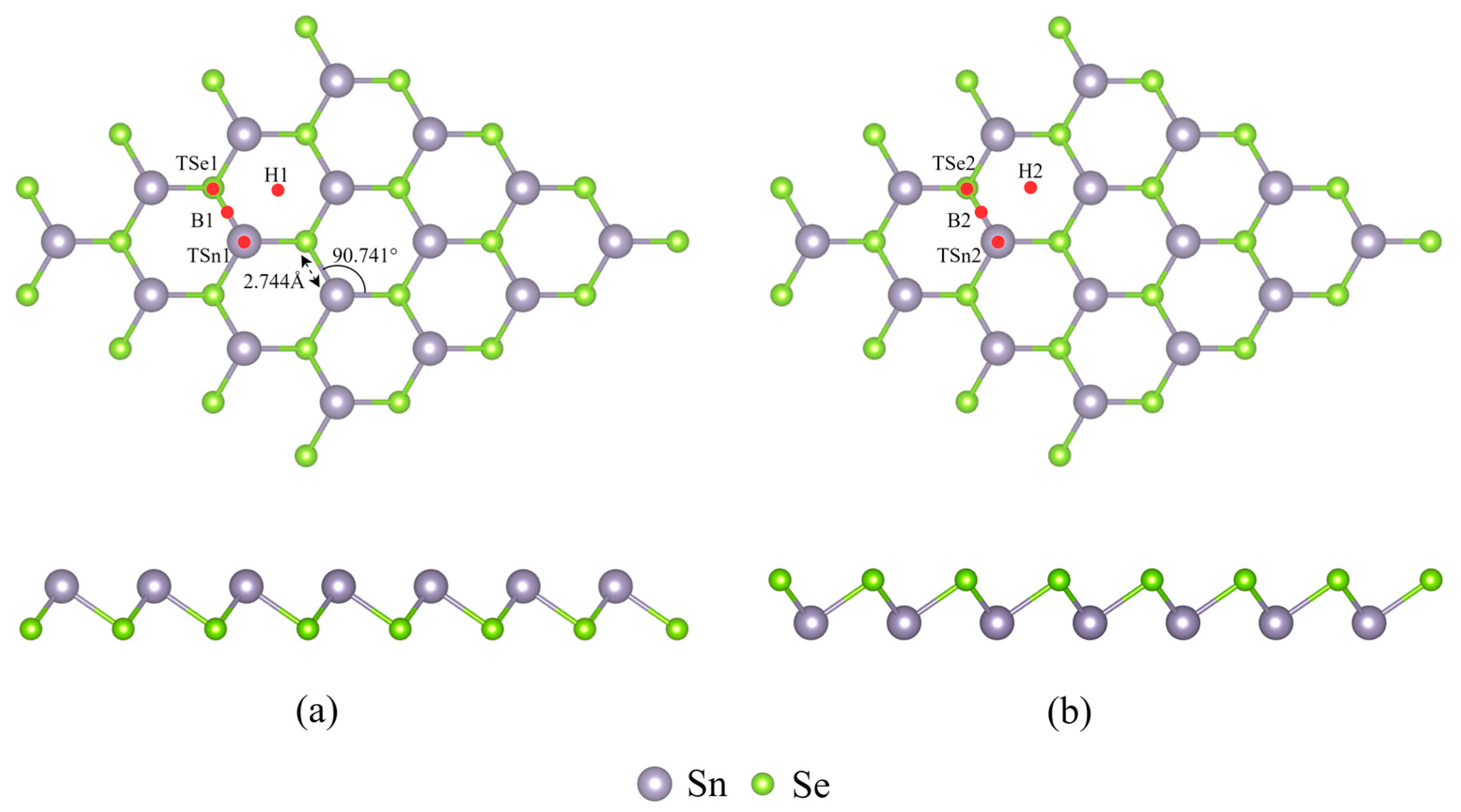

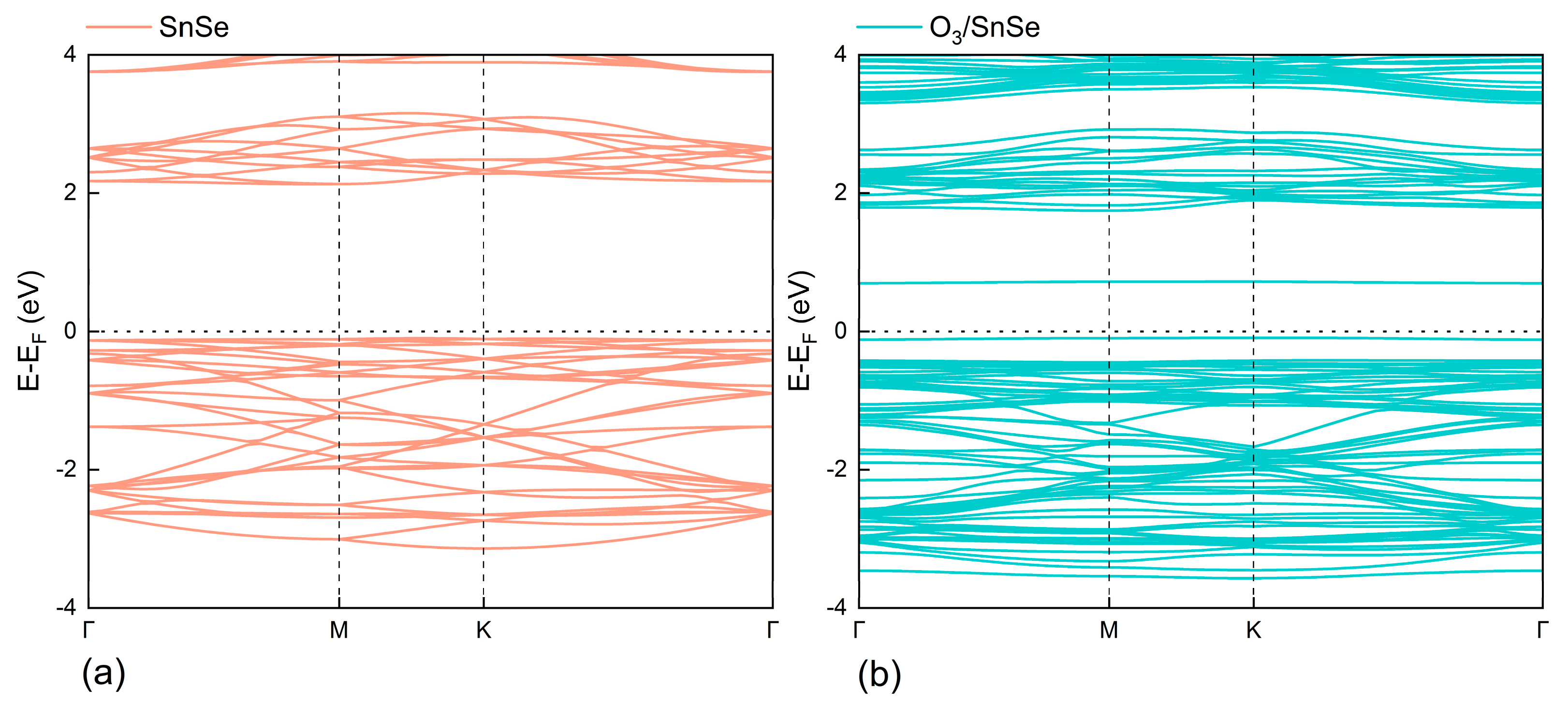
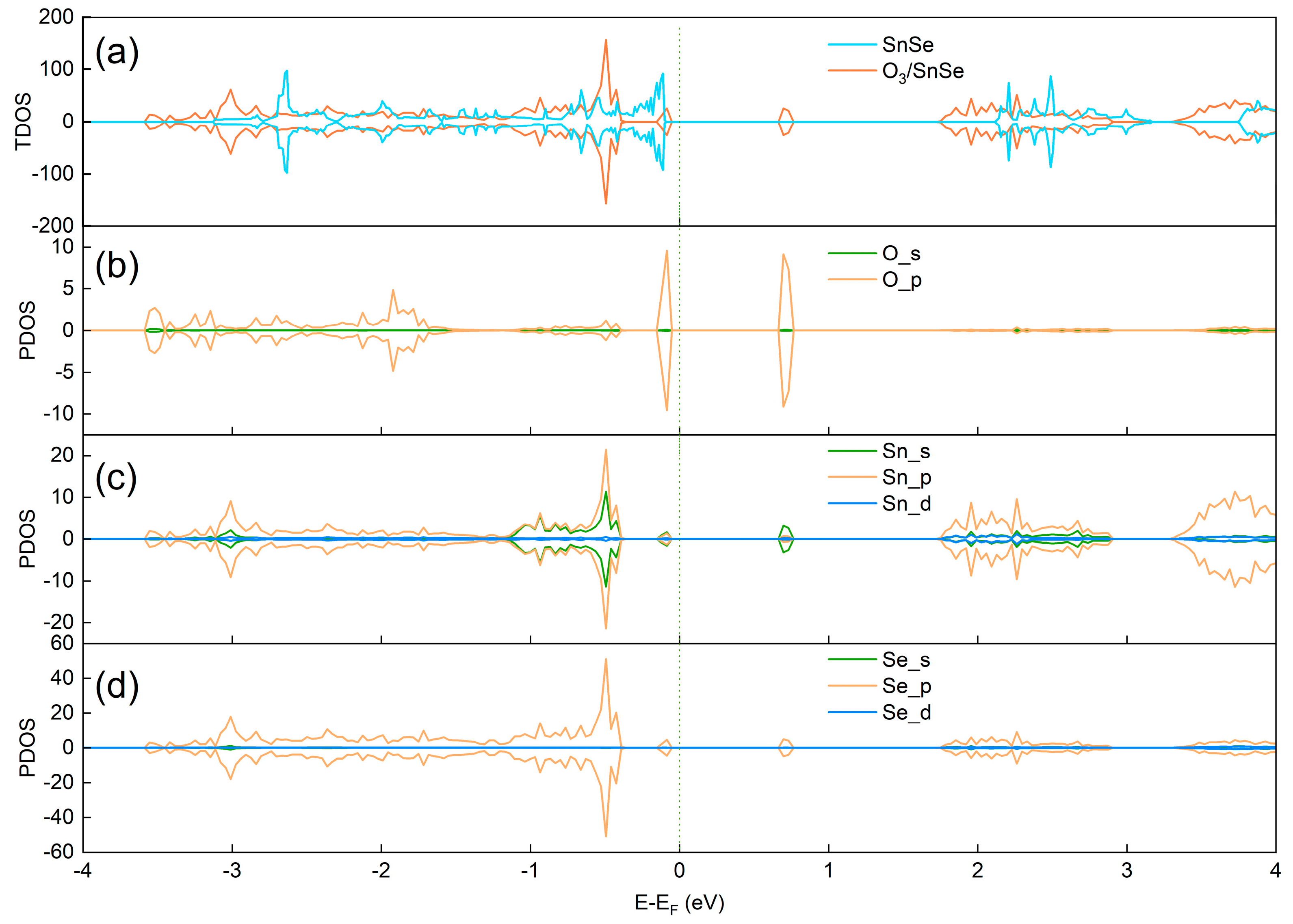
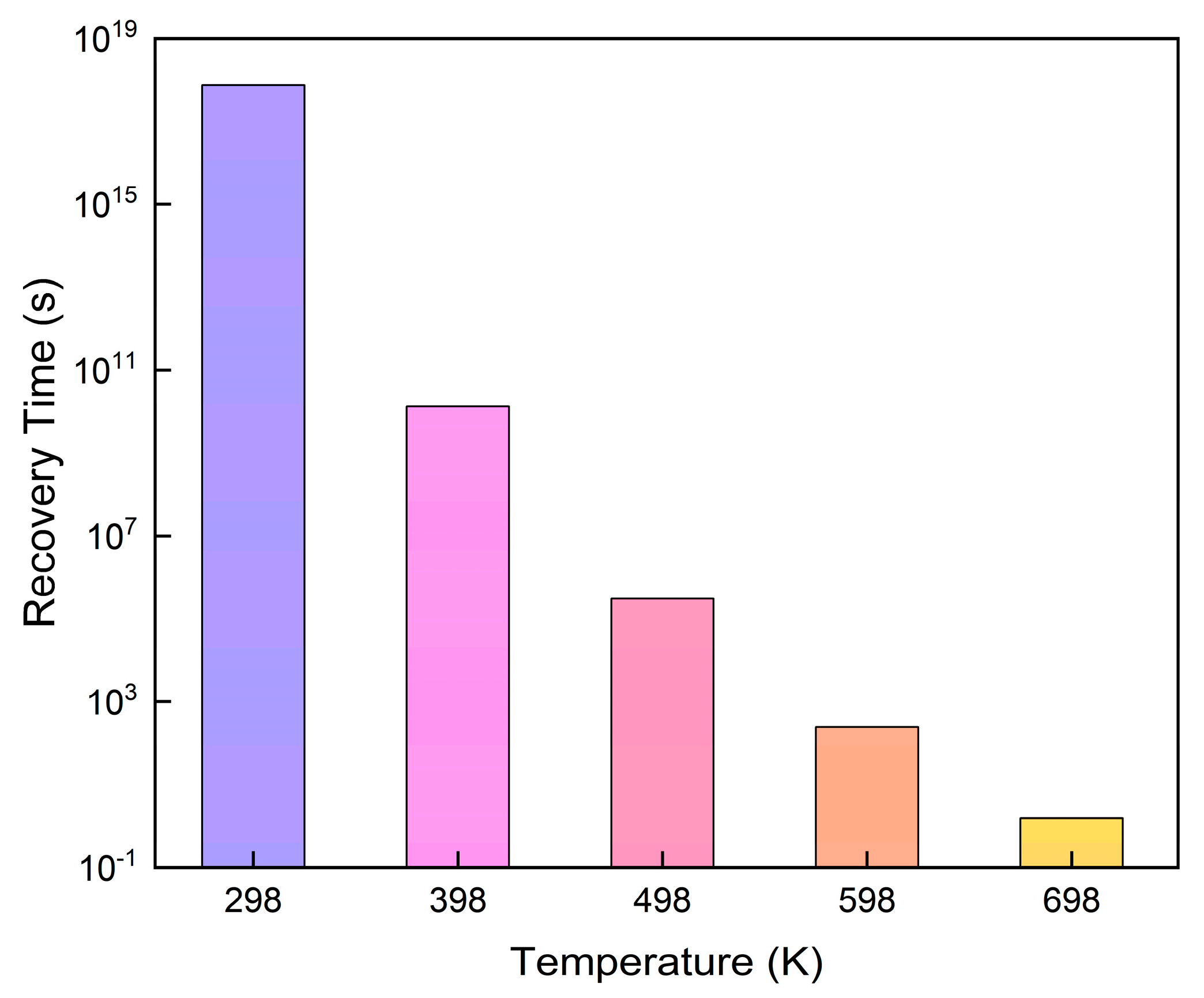

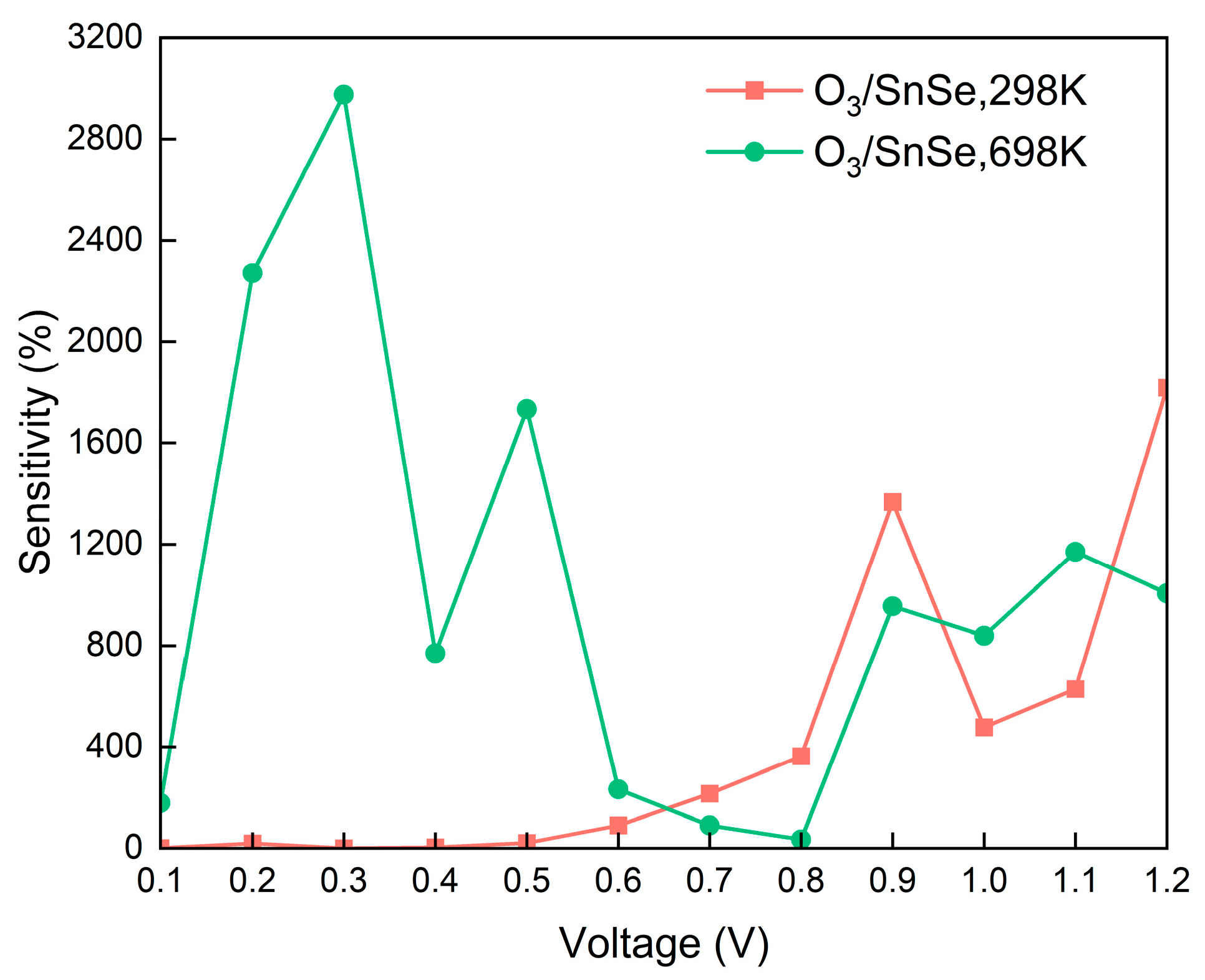
Disclaimer/Publisher’s Note: The statements, opinions and data contained in all publications are solely those of the individual author(s) and contributor(s) and not of MDPI and/or the editor(s). MDPI and/or the editor(s) disclaim responsibility for any injury to people or property resulting from any ideas, methods, instructions or products referred to in the content. |
© 2024 by the authors. Licensee MDPI, Basel, Switzerland. This article is an open access article distributed under the terms and conditions of the Creative Commons Attribution (CC BY) license (https://creativecommons.org/licenses/by/4.0/).
Share and Cite
Wu, J.; Li, Z.; Liang, T.; Mo, Q.; Wei, J.; Li, B.; Xing, X. Density Functional Theory Provides Insights into β-SnSe Monolayers as a Highly Sensitive and Recoverable Ozone Sensing Material. Micromachines 2024, 15, 960. https://doi.org/10.3390/mi15080960
Wu J, Li Z, Liang T, Mo Q, Wei J, Li B, Xing X. Density Functional Theory Provides Insights into β-SnSe Monolayers as a Highly Sensitive and Recoverable Ozone Sensing Material. Micromachines. 2024; 15(8):960. https://doi.org/10.3390/mi15080960
Chicago/Turabian StyleWu, Jiayin, Zongbao Li, Tongle Liang, Qiuyan Mo, Jingting Wei, Bin Li, and Xiaobo Xing. 2024. "Density Functional Theory Provides Insights into β-SnSe Monolayers as a Highly Sensitive and Recoverable Ozone Sensing Material" Micromachines 15, no. 8: 960. https://doi.org/10.3390/mi15080960
APA StyleWu, J., Li, Z., Liang, T., Mo, Q., Wei, J., Li, B., & Xing, X. (2024). Density Functional Theory Provides Insights into β-SnSe Monolayers as a Highly Sensitive and Recoverable Ozone Sensing Material. Micromachines, 15(8), 960. https://doi.org/10.3390/mi15080960





